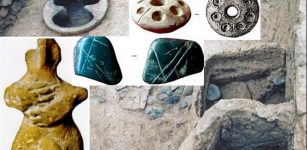Mysterious Balkåkra Disc – Rare Strange Bronze Artifact Found In A Bog
Ellen Lloyd - AncientPages.com - A strange artifact was found in 1847 in a bog in Balkåkra a village in south of Skåne, near the town Ystad, Sweden. The object suggests some form of ritual use within the religion of the Bronze Age.
A local teacher sent the find by steamboat to the Museum of National Antiquities in Stockholm. There is no further information available about the find circumstances, and the exact find place has never been located.
There are different opinions regarding its original purpose. It remains unclear whether this was an ancient drum, a sun altar, a gong, a throne, or something else. An identical bronze object was found in a two-meter-deep sandpit at Hasfalva (then called Haschendorf) near Sopron in northern Hungary, in 1913.
Both objects are the only of their kind found in the world and both objects are approximately 28 cm high and weigh around 4,700 grams.
It is likely that they were manufactured by the same craftsman in the same workshop (one of the first examples of serial production?), located somewhere in Central Europe, probably the Donau area in the early Bronze Age (1500 years BC).
The Balkåkra artifact. It consists of a bronze disc ca. 41 cm in diameter and resting on a bronze frame, height ca. 28 cm. It was found in a peat bog in Balkåkra Parish in southern Sweden and is dated to the Early Bronze Age, approx. 1500 – 1300 BC. Photo credits: G. Jansson, Museum of National Antiquities, Stockholm
The object from Balkåkra consists of a dish-shaped disc with zigzag-lines, similar to a sun depiction. It is attached to an open-work frame ending with wheel symbols that signify movement, and the discs have been interpreted as symbols of the sun.
The frame is composed of 10 parts that are put together with rivets. On each module, there are lines or dots. They show the place of the module in the structure.
See also:
The Bimaran Casket – Rare Golden Artifact Found In Ancient Stupa
Mysterious Teotihuacan ‘Host’ Figurines From Metepec, Mexico
Amazing ‘Guennol Lioness’ – One Of The Greatest Ancient Works Of Art Of All Time
Scandinavian archaeologists date the objects to c. 1500 BC while their Hungarian colleagues date them to 1000-800 BC. First metal analyses of the objects were made in 1985.
Metal analyses of the Balkåkra disc resulted in the values 89 % copper and 10 % tin, with silver, lead and iron together comprising the remaining 1 %; the results were about the same for the disc from Hasfalva, Hungary.
What is unique about these two objects is their size and appearance. They pose a mystery because we do not know function in the prehistoric society in which they were created. Both objects were found upside down, such that the disc lay at the bottom with the frame resting on it and the wheels facing upwards. It is presumed that this was the position used when the objects were stored or transported.
Many archaeologists have suggested the Balkåkra disc was a drum used in the Bronze-Age cult of the Sun, but for now, these are mere speculations and we do not know the true purpose of this enigmatic object.
Written by Ellen Lloyd – AncientPages.com
Copyright © AncientPages.com All rights reserved. This material may not be published, broadcast, rewritten or redistributed in whole or part without the express written permission of AncientPages.com
More From Ancient Pages
-
 Death Of Kvasir And How Famous Mead Of Poetry Was Created, Stolen And Finally Recovered By Odin
Featured Stories | Apr 14, 2018
Death Of Kvasir And How Famous Mead Of Poetry Was Created, Stolen And Finally Recovered By Odin
Featured Stories | Apr 14, 2018 -
 Arborglyphs – Basque Immigrant Sheepherders Left Their Marks On Aspen Trees In The American West
Featured Stories | Jul 15, 2024
Arborglyphs – Basque Immigrant Sheepherders Left Their Marks On Aspen Trees In The American West
Featured Stories | Jul 15, 2024 -
 Disbelief In Human Evolution Is Linked To Prejudice And Racism – Scientists Say
Human Beginnings | Apr 5, 2022
Disbelief In Human Evolution Is Linked To Prejudice And Racism – Scientists Say
Human Beginnings | Apr 5, 2022 -
 Shengavit Of Kura Araxes Culture: One Of Armenia’s Historical Sites Inhabited Since At Least 3200 BC
Civilizations | Apr 13, 2021
Shengavit Of Kura Araxes Culture: One Of Armenia’s Historical Sites Inhabited Since At Least 3200 BC
Civilizations | Apr 13, 2021 -
 Anglo-Saxon Warlord’s Grave: Archaeologists And Metal-Detectorists Work Together
Archaeology | Oct 7, 2020
Anglo-Saxon Warlord’s Grave: Archaeologists And Metal-Detectorists Work Together
Archaeology | Oct 7, 2020 -
 Mysterious Abaj Takalik Of Guatemala And Intriguing Relationship Between Olmec and Maya
Civilizations | Mar 16, 2020
Mysterious Abaj Takalik Of Guatemala And Intriguing Relationship Between Olmec and Maya
Civilizations | Mar 16, 2020 -
 Hidden Inca Water System Beneath The Machu Picchu Jungle Discovered By LIDAR
Archaeology | Mar 11, 2022
Hidden Inca Water System Beneath The Machu Picchu Jungle Discovered By LIDAR
Archaeology | Mar 11, 2022 -
 Shattering The Myth Of Men As Hunters And Women As Gatherers
Archaeology | Jun 29, 2023
Shattering The Myth Of Men As Hunters And Women As Gatherers
Archaeology | Jun 29, 2023 -
 On This Day In History: Magellan’s Expedition Circumnavigates Globe – On Sep 6, 1522
News | Sep 6, 2016
On This Day In History: Magellan’s Expedition Circumnavigates Globe – On Sep 6, 1522
News | Sep 6, 2016 -
 Viking Sword Unearthed In Grave Excavated by Archaeologists In Central Norway
Archaeology | Aug 27, 2020
Viking Sword Unearthed In Grave Excavated by Archaeologists In Central Norway
Archaeology | Aug 27, 2020 -
 Controversial Stone Statues Of Niulang And Zhinyu And The Legend Of The Heavenly Queen And Milky Way
Artifacts | Sep 8, 2017
Controversial Stone Statues Of Niulang And Zhinyu And The Legend Of The Heavenly Queen And Milky Way
Artifacts | Sep 8, 2017 -
 Survivors Of The Latest Ice Age Thrived Near The Sea Of Galilee 23,000 Years Ago
Archaeology | Jan 27, 2022
Survivors Of The Latest Ice Age Thrived Near The Sea Of Galilee 23,000 Years Ago
Archaeology | Jan 27, 2022 -
 Anglo-Saxon Previously Unknown Monastic Or Trading Center – Discovered
Archaeology | Mar 7, 2016
Anglo-Saxon Previously Unknown Monastic Or Trading Center – Discovered
Archaeology | Mar 7, 2016 -
 Slovenia’s Unique Discovery Of Masts, Sails And Small Harbor Found At The Bottom Of The Adriatic Sea
Archaeology | Apr 2, 2024
Slovenia’s Unique Discovery Of Masts, Sails And Small Harbor Found At The Bottom Of The Adriatic Sea
Archaeology | Apr 2, 2024 -
 John Hawkwood ‘John Sharp’: Feared, English Mercenary And His White Company In 14th Century Italy
Featured Stories | Jun 20, 2020
John Hawkwood ‘John Sharp’: Feared, English Mercenary And His White Company In 14th Century Italy
Featured Stories | Jun 20, 2020 -
 Jeanne de Clisson ‘Lioness Of Bretagne’: Her Black Painted Ships With Red Sails Terrorized English Channel
Featured Stories | Oct 4, 2019
Jeanne de Clisson ‘Lioness Of Bretagne’: Her Black Painted Ships With Red Sails Terrorized English Channel
Featured Stories | Oct 4, 2019 -
 Mystery Of The Lavau Celtic Prince And The Beautiful Ancient Artifacts Hidden In His 2,500-Year-Old Tomb
Archaeology | Jun 5, 2017
Mystery Of The Lavau Celtic Prince And The Beautiful Ancient Artifacts Hidden In His 2,500-Year-Old Tomb
Archaeology | Jun 5, 2017 -
 Early European Farmers Traced To Anatolia, DNA Study Shows
Archaeology | Jan 5, 2016
Early European Farmers Traced To Anatolia, DNA Study Shows
Archaeology | Jan 5, 2016 -
 Mysterious Etruscan Stone Structures Hidden In The Malano Forest – Evidence Of Ancient Unknown High-Tech Knowledge?
Featured Stories | Dec 19, 2020
Mysterious Etruscan Stone Structures Hidden In The Malano Forest – Evidence Of Ancient Unknown High-Tech Knowledge?
Featured Stories | Dec 19, 2020 -
 On This Day In History: Naval Battle Of Porto Bello Begins – On Nov 20, 1739
Featured Stories | Nov 20, 2016
On This Day In History: Naval Battle Of Porto Bello Begins – On Nov 20, 1739
Featured Stories | Nov 20, 2016

